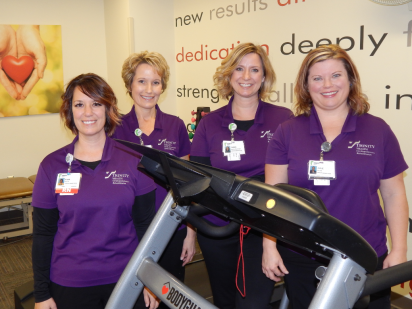The newest program through Trinity Health’s Cardiopulmonary Rehabilitation is geared toward patients with Peripheral artery disease.
Peripheral artery disease, or PAD, is the narrowing of the peripheral arteries serving the legs (most commonly), stomach, arms, and head. PAD and coronary artery disease are caused by atherosclerosis, which narrows and blocks arteries in critical regions of the body. According to the National Heart Lung and Blood Institute, one in every 20 Americans over the age of 50 has PAD.
Symptoms can vary, depending on which artery is blocked, explained Julie Rood, RN, with Trinity Health’s Cardiopulmonary Rehabilitation department. “Most times, they have pain in the legs. That’s where PAD is happening.”
The most common symptoms of PAD involve cramping, pain, or tiredness in the leg or hip muscles while walking or climbing stairs. Many people mistake the symptoms of PAD for something else, and it often goes undiagnosed. If left untreated, PAD can lead to gangrene and amputation.
There are added risks for PAD, such as having high blood pressure, high cholesterol, smoking, and diabetes, Rood said.
If you are at risk for (or diagnosed with) peripheral artery disease, it can be controlled by following a heart-healthy lifestyle and following the doctor’s recommendations. One such recommendation includes regular exercise – such as the PAD program – which can help open alternative small vessels (collateral flow) and the limitation in walking often improves.
To get into the program, patients need to be symptomatic and have a referral from their physician. At the first visit, patients receive information on cardiovascular disease, risk factor modification, education, counseling, behavioral intervention, and outcome assessments, Rood said.
“We do a structured exercise session within a supervised setting,” Rood said. “The primary exercise training goal is to reduce overall ambulatory claudication pain. Obviously, we want them to walk farther without limiting pain. That increases their quality of life.
“We have a pain scale, because obviously these patients are symptomatic, so we will ask them while they’re on the treadmill,” she added.
Guidelines through the American Association of Cardiovascular and Pulmonary Rehabilitation prefers patients to exercise on a treadmill. “They want them to walk longer on the treadmill,” Rood said. “The treadmill is the best machine for these patients. However, other exercise options include the Elliptical bike and Arm ergometer.”
For the month of February, cardio rehab has offered heart-healthy challenges for its patients by asking them to try five different things they can do outside of their cardio rehab routine, explained Heidi Zaderaka, RRT, director of Cardiopulmonary Rehab. “These are personal challenges for our patients to encourage them to participate outside of cardio rehab, with a heart-healthy lifestyle.”
If you show signs of PAD, see your healthcare provider, or contact Trinity Health Cardiopulmonary Rehabilitation at 701-857-2338.

